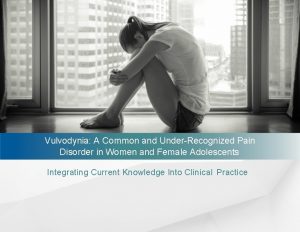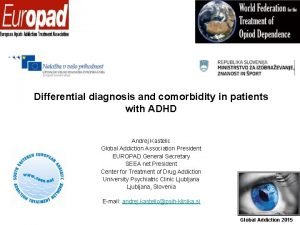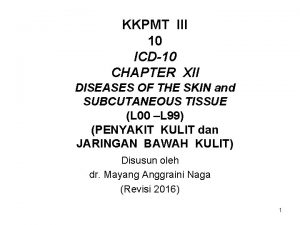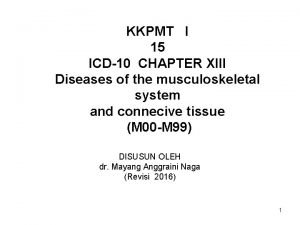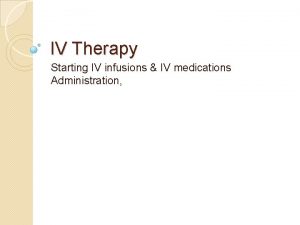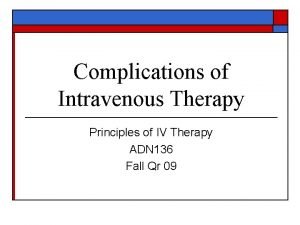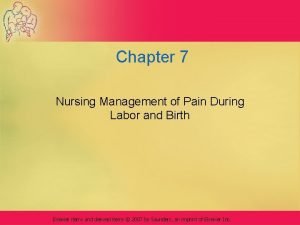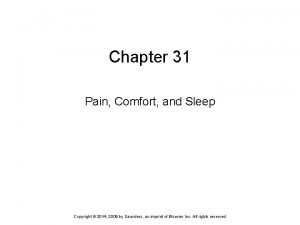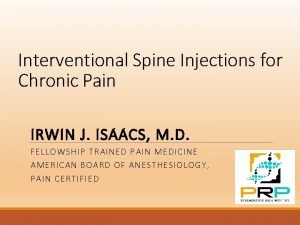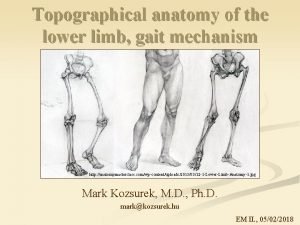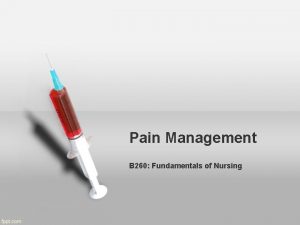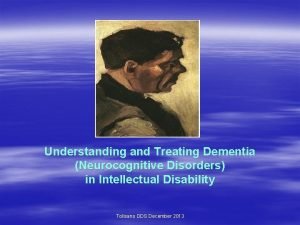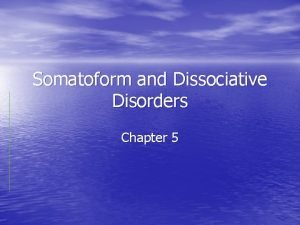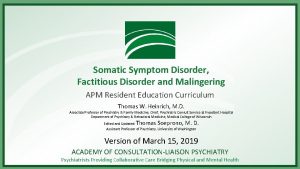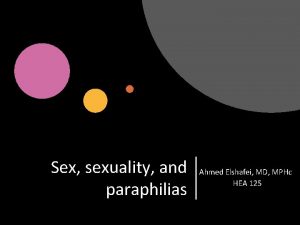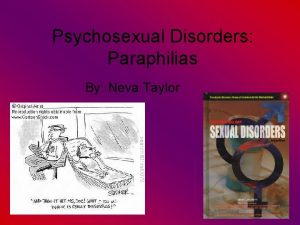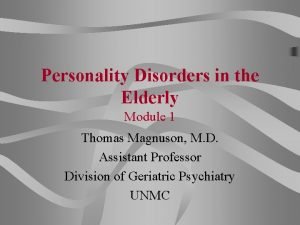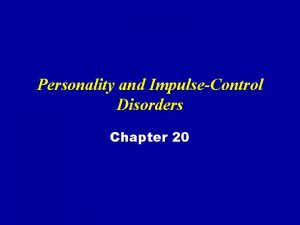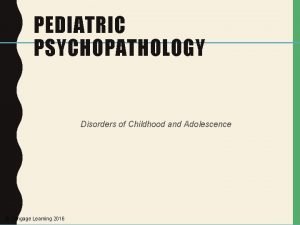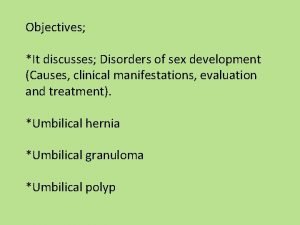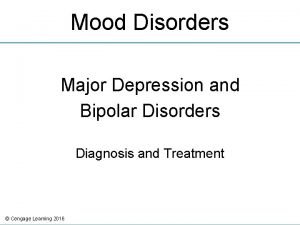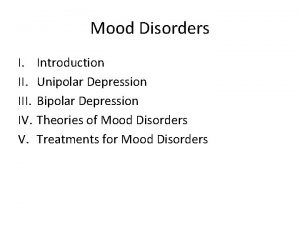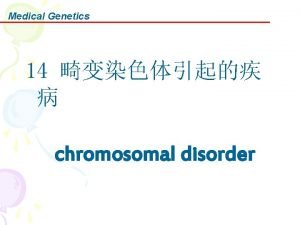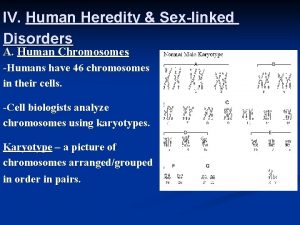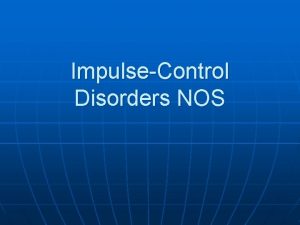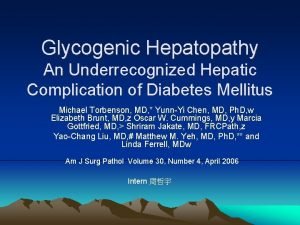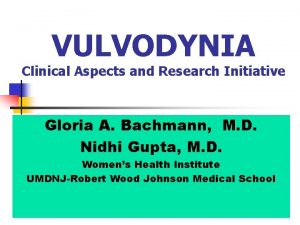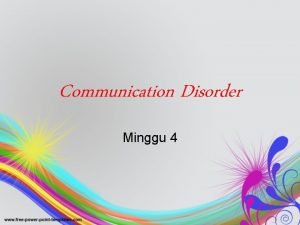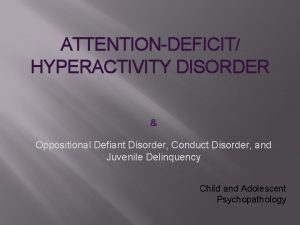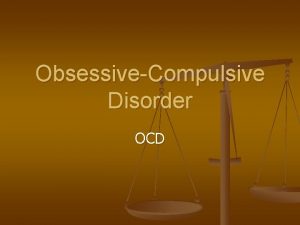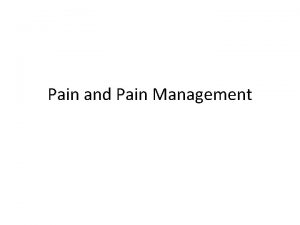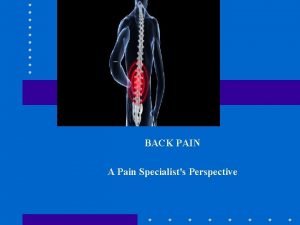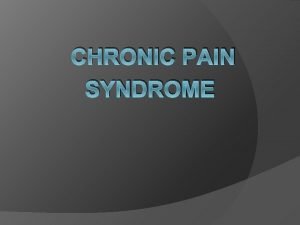Vulvodynia A Common and UnderRecognized Pain Disorder in





















































































- Slides: 85

Vulvodynia: A Common and Under-Recognized Pain Disorder in Women and Female Adolescents Integrating Current Knowledge Into Clinical Practice

Learning Objectives At the end of this session, learners will be able to: Recognize vulvodynia as a prevalent, misdiagnosed, and underresearched chronic pain disorder affecting millions of women and adolescent girls Define vulvodynia and its subtypes Summarize what is known about the pathophysiology of vulvodynia Identify the infectious, inflammatory, neoplastic and neurologic disorders that need to be ruled out in order to make a diagnosis of vulvodynia Perform a comprehensive exam to diagnose the condition Implement an individualized, multidisciplinary treatment regimen

Historical Section. Perspective #: Title Early Descriptions Contents • • Current Contents. Definition

EARLY DESCRIPTIONS OF VULVODYNIA 1888 1929 -1974 1975 1880 “Hyperaesthesia of the Vulva” Thomas described as “excessive sensibility of the nerves supplying the mucous membrane of some portion of the vulva, sometimes. . . confined to the vestibule. . . other times to one labium minus. ” Thomas 1880 Historical Perspective 4

EARLY DESCRIPTIONS OF VULVODYNIA 1880 1928 1929 -1974 1975 1888 “Supersensitiveness of the Vulva” Skene: “This disease. . . is characterized by the supersensitiveness of the vulva. . . No redness or other external manifestation of the disease is visible. . . When the examining finger comes in contact with the hyperaesthetic part, the patient complains of pain, which is sometimes so great as to cause her to cry out. Sexual intercourse is equally painful and becomes, in aggravated cases, impossible. ” Skene 1888 Historical Perspective 5

EARLY DESCRIPTIONS OF VULVODYNIA 1880 1888 1929 -1974 1975 1928 “Sensitive Deep Red Spots” Kelly described “exquisitely sensitive deepred spots in the mucosa of the hymenal ring as a fruitful source of dyspareunia. ” Kelly 1928 Historical Perspective 6

EARLY DESCRIPTIONS OF VULVODYNIA 1880 1888 1928 1975 1929 -1974 No mention of the condition in medical texts for 5 decades. Historical Perspective 7

EARLY DESCRIPTIONS OF VULVODYNIA 1880 1888 1929 -1974 1975 “Burning Vulva Syndrome” Vulvodynia is defined as burning vulva syndrome by the International Society for the Study of Vulvovaginal Disease (ISSVD) at 1975 World Congress. Mc. Kay 1984, Moyal-Barracco 2004, Haefner 2007 Historical Perspective 8

CURRENT DEFINITION The current ISSVD definition of vulvodynia is: • Vulvar pain of at least 3 months duration, without a clear identifiable cause, which may have potential associated factors. • Diagnosis of exclusion • Idiopathic pain disorder Bornstein 2016 Historical Perspective 9

Magnitude of the Problem Prevalence • Incidence • Remission Misdiagnosis • Economic impact • Quality of life

PREVALENCE & INCIDENCE Prevalence Vulvodynia has been documented in Four independent NIH-funded preadolescent girls (Reed 2008). A study population-based studies, three of of adolescent girls aged 12 -19 suggests which included a clinical confirmation that the condition is quite prevalent component, demonstrate a point among young women (Landry 2009). prevalence of 3 -7% in reproductive-aged women (Harlow 2003, Arnold 2007, Reed Incidence 2004, Reed 2006). Approximately 7% of Annual incidence is 3. 1% in one study American women will have symptoms (Reed 2012). More recently, the consistent with vulvodynia by age 40, incidence was 4. 2 cases per 100 woman- which significantly differ by ethnicity years and differed by age, ethnicity and (Harlow 2014). marital status (Reed 2014). Magnitude of the Problem 11

REMISSION RATES Remission History of any remission ranges from 26 to 38%, depending on duration of pain (Nguyen 2015). In other population-based studies, remission ranged from 17 -25%, with a rate of remission incidence of 22% over two years (Reed/Haefner 2008, Reed 2012). Magnitude of the Problem 12

AFFECTED POPULATIONS Affected Populations All ages affected, although the incidence of symptom onset appears highest between ages 18 to 25 (Harlow 2003, Reed 2012, Harlow 2014) All ethnicities affected, although Hispanic women have an increased risk (Harlow 2003, Reed 2012, Harlow 2014, Reed 2014) and different subtypes (Nguyen 2015). Magnitude of the Problem 13

MISDIAGNOSIS & ECONOMIC IMPACT Misdiagnosis is Common 2003: First NIH-funded population-based study (Harlow 2003) • 60% of women consulted at least 3 doctors in seeking a diagnosis; 40% of them remained undiagnosed after 3 medical consultations. 2012: Recent NIH-funded population-based study (Reed 2012) • Only 1. 4% of women seeking medical care were accurately diagnosed. Significant Economic Impact US direct/indirect cost is $31 -$72 billion (Xie 2012). Magnitude of the Problem 14

QUALITY OF LIFE This graphic summarizes common themes experienced by women with vulvodynia Confusion About and their interrelation (Donaldson 2010). Onset of Pain Living with vulvodynia often limits certain activities of daily living, such as sitting for extended periods, and engaging in Deleterious Consequences on Physical, Emotional Fruitless Search for Causal Attributions sexual intercourse and physical exercise. In severe cases, women have to resign from their jobs and apply for disability. and Sexual Health and Relationships Self-Management Attempts with Delay in Various Strategies Treatment for Provide Little Serious Health Condition Numerous Barriers Relief Several studies summarize the negative biopsychosocial outcomes, personal distress and sexual dysfunction reported by vulvodynia sufferers. to Seeking Medical Care and Help Magnitude of the Problem 15

QUALITY OF LIFE Xie found that women with vulvodynia reported finding a personally acceptable report lower quality of life scores than level of pain (Johnson 2015). Stigma and kidney transplant recipients and those isolation are common. Only 1 in 4 women with prior osteoporosis-related report feeling comfortable discussing the fractures (Xie 2012). Newly diagnosed condition with women friends (Nguyen/ women report substantial impact of Mac. Lehose 2012). They also report an vulvar pain on their lives, and little increase in feelings of invalidation and control over their symptoms (Piper isolation when they have co-existing pain 2012). Among women of reproductive disorders (Nguyen/Ecklund 2012). age, Johnson found that barriers to consistent health carefrequently experienced in early adulthood contributed to not finding successful medical management (Johnson 2015). However, those who became pregnant Magnitude of the Problem 16

Anatomy and Neurobiology of the Urogenital Tract Vulva and Vulvar Vestibule • Innervation of the Vulva Pelvic Floor Musculature

VULVA AND VULVAR VESTIBULE Vulva Prepuce Image courtesy of Dr. Libby Edwards. Vestibule Reprinted with permission from Glazer HI and Rodke G, The Vulvodynia Survival Guide, New Harbinger Publications, 2002 Reprinted with permission from the John O. L. De. Lancey, MD collection For a thorough review on vulvar anatomy and physiology, see Farage 2006. Anatomy & Neurobiology of the Urogenital Tract 18

INNERVATION OF THE VULVA D E Farage 2012 Images courtesy of Drs. Denniz Zolnoun and Georgine Lamvu Anatomy & Neurobiology of the Urogenital Tract 19

PELVIC FLOOR MUSCULATURE Anatomy & Neurobiology of the Urogenital Tract 20

Terminology and Classification ISSVD Classification: Vulvar Pain and Vulvodynia Other Terms

ISSVD CLASSIFICATION: VULVAR PAIN Vulvar pain related to a specific disorder, i. e. , NOT vulvodynia • Infectious (recurrent candidiasis, herpes) • Inflammatory (lichen sclerosus, lichen planus, immunobullous disorders) • Neoplastic (Paget’s disease, squamous cell carcinoma) • Neurologic (post-herpetic neuralgia, nerve compression or injury, neuroma) • Trauma (female genital cutting, obstetrical) • Iatrogenic (post-operative, chemotherapy, radiation) • Hormonal deficiencies (genito-urinary syndrome of menopause, lactational amenorrhea) Bornstein 2016 Terminology and Classification 22

ISSVD CLASSIFICATION: VULVODYNIA Vulvodynia is vulvar pain of at least 3 months duration, without a clear identifiable cause, which may have potential associated factors*. Descriptors: • Generalized (multiple areas of the vulva involved), localized (one area of the vulva involved, e. g. , clitorodynia, hemi-vulvodynia) or mixed (localized and generalized) • Provoked (insertional, contact), spontaneous or mixed (provoked and spontaneous) - Provoked pain local to the vestibule: “provoked vestibulodynia” (previously vulvar vestibulitis syndrome) • Onset (primary or secondary) • Temporal pattern (intermittent, persistent, constant, immediate, or delayed) Terminology and Classification 23

OTHER TERMS - CONFUSION IS COMMON Generalized Vulvodynia Provoked Vestibulodynia • Hyperaesthesia of the vulva • Vulvar Vestibulitis Syndrome • Dysesthetic Vulvodynia • Vestibular Adenitis • Vulvar Dysesthesia • Minor Vestibular Gland • Essential Vulvodynia Syndrome • Localized Provoked Vulvodynia Terminology and Classification 24

Pathophysiology Potential Factors Associated with Vulvodynia • Pain Transmission Neuroproliferation • Mast Cells

POTENTIAL FACTORS ASSOCIATED WITH VULVODYNIA Potential Factor* Co-morbidities and other pain syndromes (eg, painful bladder syndrome, fibromyalgia, irritable bowel syndrome, temporomandibular disorder) Level of Evidence Genetics 2 a 2 b Hormonal factors (eg, pharmacologically induced) 2 b Inflammation 2 b Musculoskeletal (eg, pelvic muscle overactivity, myofascial, biomechanical) 2 b Neurologic mechanisms: central (spine, brain) and peripheral 2 b Neuroproliferation 2 b Psychosocial factors (eg, mood, interpersonal, coping, role, sexual function) 2 b Structural defects (eg, perineal descent) 2 b Bornstein 2016 *The factors are ranked by alphabetical order. Pathophysiology 26

NORMAL PAIN TRANSMISSION VS. PROPOSED MECHANISMS OF ALTERED PAIN TRANSMISSION IN VULVODYNIA Pathophysiology 27

NEUROPROLIFERATION One possible pathophysiologic mechanism of vestibulodynia is neuroproliferation (Bornstein 1997, Bornstein 2008). Subepithelial and intraepithelial nerve fibers have been detected in patients with vestibulodynia. Branching of the nerve fibers within the epithelium is rarely seen. Pathophysiology 28

MAST CELLS In vestibulodynia, there is frequently an increase in mast cell number and activity. Mast cells show degranulation. The discharged granules contain tryptase, histamine, serotonin, bradykinin, heparanase, nerve growth factor, etc. Some of these enzymes may participate in the pathogenesis of vestibulodynia (Bornstein 2004). Pathophysiology 29

Differential Diagnosis Disorders known to cause vulvar pain (rule-out diagnoses) vs. Vulvodynia

POSSIBLE RISK FACTORS FOR VULVODYNIA Postulated risk factors reported in Early age of first intercourse, pain with the literature to date: first intercourse, pain with/after sex Vulvovaginal infection Early menarche Oral contraceptive use Nulliparity Genetic variability Childhood enuresis, nocturnal urination, Urinary burning, pain with wiping Dysmenorrhea, chronic pain in other areas of the body Pain with bike riding Autoimmune disease, altered immuno- Difficulty or severe pain with first inflammatory response tampon use Allergies, vulvar dermatologic disorders Adverse life experiences Differential Diagnosis 31

RULE-OUT DIAGNOSES CHRONIC VULVAR PAIN No visible findings except possible erythema. Hyperalgesia (painful stimuli induce sensitivity). Allodynia (non-painful stimuli induces pain). Pain can be: primary or secondary; spontaneous or provoked; intermittent, persistent, constant, immediate, delayed Visible and/or neurologic findings Infectious, inflammatory, neoplastic, neurologic, traumatic, iatrogenic, hormonal deficiencies (treat accordingly) Pain is localized to one part of the vulva (vestibule, clitoris, labia, etc. ) Pain throughout the entire vulva though some parts may be more painful than others. Provocation typically exacerbates symptoms. Pain may be described as burning, stabbing, stinging, etc. Generalized Vulvodynia Clitorodynia - pain confined to the clitoris. Can be described as burning or stabbing pain or less commonly persistent arousal (AKA persistent genital arousal disorder PGAD). Haefner 2007, Bornstein 2016 Vestibulodynia (AKA vulvar vestibulitis (VVS) or provoked vestibulodynia (PVD). Primary if pain began at first vaginal penetration attempt. Secondary if pain began after a period of pain-free vaginal penetration. Differential Diagnosis 32

RULE-OUT DIAGNOSES INFECTIOUS DISORDERS Vulvovaginal Candidiasis Courtesy of CDC Public Health Image Library Courtesy of Dr. Andrew Goldstein For information on diagnosis and treatment, see Ledger 2007 and Nyirjesy 2008. Differential Diagnosis 33

RULE-OUT DIAGNOSES INFECTIOUS DISORDERS Trichomoniasis Genital Herpes Courtesy of CDC Public Health Image Library Courtesy of Dr. Libby Edwards For information on diagnosis and treatment, see Ledger 2007, Soper 2004 & Schwebke 2004. For information on diagnosis and treatment, see Ledger 2007 & Kimberlin 2004. Differential Diagnosis 34

RULE-OUT DIAGNOSES INFLAMMATORY DISORDERS Lichen Sclerosus Image courtesy of Dr. Libby Edwards Image courtesy of Dr. Andrew Goldstein For information on diagnosis and treatment, see Chi 2012, Moyal-Barracco 2014. Differential Diagnosis 35

RULE-OUT DIAGNOSES INFLAMMATORY DISORDERS Lichen Planus Image courtesy of Dr. Andrew Goldstein Image courtesy of Dr. Libby Edwards For information on diagnosis and treatment, see Lewis 2013, Moyal-Barracco 2014, Burrows 2008. Differential Diagnosis 36

RULE-OUT DIAGNOSES INFLAMMATORY DISORDERS Contact Dermatitis Lichen Simplex Chronicus Courtesy of Dr. Libby Edwards Courtesy of Dr. Andrew Goldstein For information on diagnosis and treatment, see Burrows 2008 & Margesson 2004. For information on diagnosis and treatment, see Moyal-Barracco 2014. Differential Diagnosis 37

RULE-OUT DIAGNOSES NEOPLASTIC DISORDERS Squamous Cell Carcinoma Images courtesy of Dr. Andrew Goldstein For information on diagnosis and treatment, see Alkatout 2015. Differential Diagnosis 38

RULE-OUT DIAGNOSES NEUROLOGIC DISORDERS Pudendal, Genitofemoral and/or Ilioinguinal Nerve Injury Can be caused by several different insults including: childbirth, sports injuries, trauma and surgery (for incontinence or for vaginal vault prolapse) (see Paulson 2011, Masata 2012, Parnell 2012, Bekker 2012) Differential Diagnosis 39

RULE-OUT DIAGNOSES NEUROLOGIC DISORDERS Pudendal Neuralgia due to Nerve Entrapment* (see Peng 2009, Insola 2010) Diagnosed by presence of all five Nantes Criteria: 1) pain in the anatomical territory of the pudendal nerve, 2) worse on sitting, 3) not usually waking the patient at night, 4) not accompanied by any objective perineal sensory loss, with 5) a positive anesthetic block of the pudendal nerve at the ischial spine (Labat 2010) Patients often present with associated urinary, anorectal, sexual, neuromuscular, and hypersensitization signs, which can complicate the diagnostic approach and therapeutic management (Labat 2010). *These disorders are many times also diagnoses of exclusion, and can, therefore, be difficult to definitively differentiate from vulvodynia. Differential Diagnosis 40

RULE-OUT DIAGNOSES NEUROLOGIC DISORDERS Peripheral Neuropathy/Neuralgia* Neuropathy induced by diabetes, chemotherapy, multiple sclerosis (see Stavraka 2012, Loprinzi 2008) Herpes zoster virus can lead to post-herpetic neuralgia masking as vulvodynia (see Oaklander 2002). Pharmacologic toxicity, eg, nitrofurantoin (see Tan 2012) *These disorders are many times also diagnoses of exclusion, and can, therefore, be difficult to definitively differentiate from vulvodynia. Differential Diagnosis 41

RULE-OUT DIAGNOSES NEUROLOGIC (AND OTHER) DISORDERS Sacral Meningeal (Tarlov) Cysts Referred pain from ruptured disc or (see Hiers 2010, Van de Kleft 1991) scarring around sacral nerve roots after disc surgery, pelvic floor muscle dysfunction and/or orthopedic condition, e. g. , labral hip tear (image below) Image courtesy of Wikimedia Commons Image courtesy of Deborah Coady Differential Diagnosis 42

RULE-OUT DIAGNOSES TRAUMA Trauma to the vulva may lead to chronic vulvar pain. • Female genital cutting • Perineal trauma • Straddle injuries - Bicycles - Falls from climbing • Injuries to pelvis - Motor vehicle accidents Differential Diagnosis 43

RULE-OUT DIAGNOSES HORMONAL DEFICIENCIES Courtesy of Dr. Andrew Goldstein Differential Diagnosis 44

RULE-OUT DIAGNOSES IATROGENIC Images Courtesy of Dr. Andrew Goldstein Differential Diagnosis 45

VULVODYNIA ASSESSMENT CHRONIC VULVAR PAIN Visible and/or neurologic findings No visible findings except possible erythema. Hyperalgesia. Allodynia. Pain can be: primary or secondary; spontaneous or provoked; intermittent, persistent, constant, immediate, delayed Infectious, inflammatory, neoplastic, neurologic, trauma, iatrogenic, hormonal deficiencies (treat accordingly) Pain is localized to one part of the vulva (vestibule, clitoris, labia, etc. ) Pain throughout the entire vulva though some parts may be more painful than others. Provocation typically exacerbates symptoms. Pain may be described as burning, stabbing, stinging, etc. Generalized vulvodynia Clitorodynia - pain confined to the clitoris. Can be described as burning or stabbing pain or less commonly persistent arousal (also know as persistent genital arousal disorder - PGAD). Haefner 2007, Bornstein 2016 Vestibulodynia (aka vulvar vestibulitis or provoked vestibulodynia (PVD)). Primary if pain began at first vaginal penetration attempt. Secondary if pain began after a period of pain-free vaginal penetration. Differential Diagnosis 46

VULVODYNIA ASSESSMENT SCREENING QUESTIONS Four Questions Highly Predictive of a Clinical Diagnosis 1) Experience genital “pain”? 2) Experience genital burning > 3 months? 3) 10 or more episodes of pain on contact with tampon insertion, sexual intercourse or gynecological exam? 4) Does pain on contact limit/prevent intercourse? Harlow 2009 Differential Diagnosis 47

2015 ISSVD, ISSWSH, IPPS CONSENSUS TERMINOLOGY AND CLASSIFICATION OF VULVODYNIA Vulvodynia is vulvar pain of at least 3 months duration, without a clear identifiable cause, which may have potential associated factors. Descriptors: • Localized (e. g. , vestibulodynia, clitorodynia), generalized or mixed (localized and generalized) • Provoked (eg, insertional, contact), spontaneous or mixed (provoked and spontaneous) • Onset (primary or secondary) • Temporal pattern (intermittent, persistent, constant, immediate, delayed) Bornstein 2016 Differential Diagnosis 48

VULVODYNIA ASSESSMENT COMPONENTS OF THE EXAMINATION After all infectious, inflammatory, neoplastic, neurologic, and other disorders are identified and treated, women are assessed for vulvodynia through a five-step examination, as described in the following slides. Step 1: Visual Examination Step 2: Cotton-Swab Examination of the Vulva and Vulvar Vestibule Step 3: Neurosensory Examination Step 4: Pelvic Floor Muscle Examination Step 5: Evaluation of Pain Comorbidity & Contributing Factors Differential Diagnosis 49

VULVODYNIA ASSESSMENT SUBJECTIVE FINDINGS: “WHERE DOES IT HURT? ” Generalized Vulvodynia Provoked Vestibulodynia “It hurts all over, all of the time. ” “It hurts at the opening only with touch or pressure. ” Less prevalent (20%) subtype More prevalent (80%) subtype Differential Diagnosis 50

VULVODYNIA ASSESSMENT STEP 1: VISUAL EXAMINATION Patient #1 Patient #2 Patient #3 Severe Erythema Moderate Erythema Minimal Erythema Severe Pain severity and subsurface inflammation do not consistently correlate with the amount of erythema observed (Bergeron 2001, Farage 2009). Reprinted with permission from Ledger, W. J. and Witkin, S. S. , Vulvovaginal Infections, Manson Publishing, London, 2007, page 103. Differential Diagnosis 51

VULVODYNIA ASSESSMENT STEP 2: COTTON SWAB EXAMINATION OF THE VULVA Using a cotton swab, test for allodynia, hypo- and hyperalgesia by applying gentle pressure to the following areas: • 1 -2 inner thigh • 3 -5 labia majora • 6 -8 interlabial sulcus • 9 clitoris, clitoral hood • 10 perineum • 11 sites within vestibule (next slide) 9 1 3 6 4 7 5 8 11 For each site, the patient: • Rates the pain severity (VAS score) • Describes the pain character (burning, raw, etc. ) 10 2 Differential Diagnosis 52

VULVODYNIA ASSESSMENT STEP 2: COTTON SWAB EXAMINATION OF VULVAR VESTIBULE Image courtesy of Dr. Denniz Zolnoun Differential Diagnosis 53

VULVODYNIA ASSESSMENT STEP 3: NEUROSENSORY EXAMINATION • Instruct the patient on ‘cotton’ vs. ‘pinprick’ sensation by touching her outer • Note sensation (normal, allodynia, hyposensitive), pain score, pain character (eg, thigh (just above the knee) with the cotton sharp, burning, shooting), and right- to portion, followed by the wooden portion, of left-side differences the cotton swab • Using the cotton swab, gently stroke (upwards) each of the sensory dermatomes • Note sensation (normal, allodynia, hyposensitive), pain score, pain character (eg, sharp, burning, shooting), and right- to leftside differences • Break the cotton swab in half and repeat exam with the sharp wooden portion of the swab using punctate pressure (apply light pressure for 1 sec) in each dermatome From ongoing NIH Grant 5 K 23 HD 053631 Differential Diagnosis 54

VULVODYNIA ASSESSMENT STEP 4: PELVIC FLOOR MUSCLE EXAMINATION Images courtesy of Dr. Denniz Zolnoun Differential Diagnosis 55

VULVODYNIA ASSESSMENT STEP 5: EVALUATION OF PAIN COMORBIDITY & CONTRIBUTING FACTORS As a consequence of living with a poorly understood, under-recognized genital pain disorder, women commonly report emotional distress and sexual impairment. Comorbid pain syndromes are also common, Assessment of comorbid disorders is including: important in selecting therapies that target all factors contributing to a • Interstitial Cystitis | Irritable Bowel Syndrome | Endometriosis • Orofacial Pain (TMJ) | Chronic Headache (Migraine, Tension Type) • Fibromyalgia | Chronic Fatigue Syndrome woman’s current pain state, including: • Pain (location(s), intensity & interference) • Emotional Functioning • Sleep Interference (both falling asleep & staying asleep) • Physical Functioning • Sexual Functioning See Comorbidity References. Differential Diagnosis 56

VESTIBULODYNIA: A DIAGNOSTIC ALGORITHM NEUROPROLIFERATION VESTIBULODYNIA WITH TENDERNESS THROUGHOUT ENTIRE VESTIBULE NEUROPROLIFERATION ACQUIRED NEUROPROLIFERATIVE CONGENITAL NEUROPROLIFERATIVE VESTIBULODYNIA HX: Allergic reaction, chronic yeast infection, polymorphisms in IL 1 RA, MBL, IL 1 B, associated with urticaria, hives, sensitive skin HX: Pain since first tampon use, speculum insertion, and coitarche. No pain free sex. Late coitarche > 25 years old. PE: Tenderness of the entire vestibule from Hart’s line to the hymen, often with erythema that worsens after touch with cotton swab. Umbilical hypersensitivity in approximately 60% of these women. LABS: increased density of c-afferent nociceptors if using S-100 of PGP 9. 5 Differential Diagnosis 57

VESTIBULODYNIA: A DIAGNOSTIC ALGORITHM INFLAMMATORY VESTIBULODYNIA WITH TENDERNESS THROUGHOUT ENTIRE VESTIBULE INFLAMMATORY VESTIBULODYNIA HX: Chronic infections, allergic reactions, copious yellowish discharge. PE: Erythema (redness), leukorrhea (thick discharge), induration (hardening of soft tissue), vaginal mucosal tenderness, cervicitis/ ectropion (inflammation of the outer cervix) CAUSES: Desquamative inflammatory vaginitis, chronic candidiasis, latex allergy/semen allergy DESQUAMATIVE INFLAMMATORY VAGINITIS RECURRENT CANDIDIASIS HX: Copious yellow vaginal discharge that ruins underwear or requires a panty liner, vulvar pruritus where discharge dries PE: Erythema, induration, thin fissures, peri-anal erythema. Discharge is often thin and yellow, not thick and white (cottage cheese-like). PE: Copious leukorrhea, vaginal mucosa erythema, cervicitis, cervical ectropion LABS: Hyphae and increased WBCs on wet mount. Positive cultures CAUSES: Unknown, but current hypothesis is either infection of unknown pathogen, erosive lichen planus, vulvovaginal atrophy, or cervical ectropion. CAUSES: Diet high in simple sugars, antibiotics, OCPs Differential Diagnosis 58

VESTIBULODYNIA: A DIAGNOSTIC ALGORITHM HORMONALLY ASSOCIATED VESTIBULODYNIA WITH TENDERNESS THROUGHOUT ENTIRE VESTIBULE HORMONALLY ASSOCIATED VESTIBULODYNIA PE: Gland ostia are erythematous, mucosal pallor with overlying erythema, decreased size of labia minora and clitoris LABS: High SHBG, low free testosterone, low estradiol CAUSES: Hormonal contraceptives, spironolactone, Tamoxifen, aromatase inhibitors, oophorectomy, amenorrhea, lactation Differential Diagnosis 59

VESTIBULODYNIA: A DIAGNOSTIC ALGORITHM PELVIC FLOOR MUSCLE DYSFUNCTION AND PUDENDAL NEURALGIA VESTIBULODYNIA TENDERNESS ONLY IN THE TENDERNESS EXTENDS OUTSIDE POSTERIOR VESTIBULE OF THE VESTIBULE OVERACTIVE PELVIC FLOOR MUSCLE DYSFUNCTION PUDENDAL NEURALGIA HX: Urinary symptoms (frequency, sensation of incomplete emptying, hesitancy) if it involves coccygeus muscle. Constipation, rectal fissures, hemorrhoids if it involves puborectalis. Associated with anxiety, low back pain, scoliosis, hip pain, “holding urine, ” excessive core strengthening exercises. HX: Often unilateral pain or significantly worse on one side. Pain can extend to the clitoris, labia, perineum, or anus and the inner thigh. History of coccyx trauma, history of hip pain or labral tear. Pain is usually better with lying prone or standing, worse with sitting. Pain improves temporarily with pudendal nerve block. PE: Pain at 4, 8 o’clock if hypertonus of pubococcygeus muscle. Pain at 6 o’clock if hypertonus of puborectalis muscle. PE: The pudendal nerve is tender when palpated at ischial spine on vaginal exam. The obturator internus muscle is usually very tender, unilateral or significantly greater on one side. Differential Diagnosis 60

Individualized Multidisciplinary Treatment

GENERAL PRINCIPLES Scientific level of evidence for almost all treatments is poor with very few RCTs. Individualized, Multidisciplinary Treatment Regimen Recommended • Components of an individualized, multidisciplinary, biopsychosocial • Multidisciplinary treatment results in reduced pain level, improvement in treatment approach are selected after sexual functioning as well as increased identifying vulvodynia subtype and patient knowledge, gain of tools/skills, contributing factors (Jodoin 2011, improved mood and psychological Spoelstra 2011, Stockdale 2014). well-being, gain of validation and support, and empowerment (Sadownik 2012, Brotto 2015). See Andrews 2011 for an evidence-based review. Individualized Multidisciplinary Treatment 62

GENERAL PRINCIPLES Treatment Outcome Varies, but Majority Improve with Treatment • Treatment response varies among patients, likely due to heterogeneity of underlying etiology. • There is currently little knowledge to predict treatment outcome, although studies are ongoing. - Heddini (2012) found that successful treatment was more likely in women with fewer concomitant pain disorders, and lower • As such, it can take many months to identify a treatment regimen that is helpful, but the majority of women will improve with treatment for variable periods of time (Ventolini 2009). - Remission rates differ among women, underscoring the heterogeneity of vulvodynia, and remission may occur without treatment (Davis 2013, Nguyen 2015). response rates were found in women with primary, rather than secondary, PVD. See Andrews 2011 for an evidence-based review. Individualized Multidisciplinary Treatment 63

COMPONENTS OF THE PROVIDER/PATIENT RELATIONSHIP Believe the patient Clearly define realistic objectives and adapt management style Avoid making her feel responsible for failure Ask “how” the Avoid pain persists rather overestimating than “why” secondary benefits Avoid making her passive and dependent Labat 2010 Individualized Multidisciplinary Treatment 64

INDIVIDUALIZED MULTIDISCIPLINARY TREATMENT First step is vulvar* self-care, eg, avoid all vulvar irritants, and chronic pain self-care Oral “Pain-Blocking” Medications (1) ^ • Tricyclic antidepressants (amitriptyline, nortriptyline) (1, 2 -4, 28, 32, 33, 91) ** • Anticonvulsants (gabapentin, pregabalin, lamotrigine, topiramate oxcarbamazepine) (1, 5 -9, 105, 106) • SSNRIs (duloxetine, venlafaxine, milnacipran) (1, 132) • In severe cases, or to manage symptoms while the dose of a long-term medication is titrated upward, other pain-relieving medications (eg, short-term opioids) can be used See Treatment References 1 -135. Individualized Multidisciplinary Treatment 65

INDIVIDUALIZED MULTIDISCIPLINARY TREATMENT Topical Formulations • Compounded topical formulations • Discontinuation of oral contraceptives can be used in conjunction with (OC) and use of a topically formulated medications (or other treatments) estrogen (and sometimes testosterone) cream is recommended for cases in • Topicals contain either a single which OC use is suspected to play a active ingredient or a combination of role in symptom development and/or ingredients (anesthetic, antidepressant, maintenance (1, 97, 103, 104) anticonvulsant) (1, 10, 30 -35, 92, 109, 110, 131) -Topical use of benzocaine and diphenhydramine should be avoided due to potential sensitization and irritation (108) -Topicals not found useful* See Treatment References 1 -135. Individualized Multidisciplinary Treatment 66

INDIVIDUALIZED MULTIDISCIPLINARY TREATMENT Nerve Blocks • Pudendal and/or caudal blocks of local • Limited studies of multilevel nerve anesthetic, or local anesthetic and blocks (subcutaneous, pudendal, steroid, have been used with varying caudal) demonstrate efficacy degrees of success (11 -15) (48, 93, 111) See Treatment References. Individualized Multidisciplinary Treatment 67

INDIVIDUALIZED MULTIDISCIPLINARY TREATMENT Pelvic Floor Muscle Therapy Pelvic floor muscle therapy, including various physical therapy techniques, biofeedback training, trigger point injections and use of vaginal dilators, has been found helpful in women who also exhibit pelvic floor muscle abnormalities, eg, spasm, weakness, instability (1, 20 -23, 31, 34, 36 -46, 94, 112). The efficacy of botulinum, Type A (BTA) has been evaluated in a double-blind placebo controlled RCT and 2 case series. Petersen et al. found no difference between administration of 100 u BTA versus placebo in level of pain, quality of life and sexual function in 64 women with provoked vestibulodynia (PVD) (82). In contrast, a prospective case series of 20 women with PVD, by Pelletier et al. , found that 80% of women reported an improvement in pain and 72% were able to have sexual intercourse following a dose of 100 u of BTA. Quality of life and sexual function also improved (126). See Treatment References 1 -135. Individualized Multidisciplinary Treatment 68

INDIVIDUALIZED MULTIDISCIPLINARY TREATMENT Pelvic Floor Muscle Therapy (cont. ) Similarly, lower doses of Botox (35 -50 u) were found and oral medication use, and improve quality of women to significantly reduce pain life, in a retrospective study of 19 with PVD. Botox is not recommended as a first-line treatment for PVD. It may be useful, however, in combination with pelvic floor physical therapy (127). For a comprehensive review, see References 47, 112. See Treatment References 1 -135. Individualized Multidisciplinary Treatment 69

INDIVIDUALIZED MULTIDISCIPLINARY TREATMENT Psychotherapy Neurostimulation • Adjunct cognitive-behavioral therapy, • Case reports of recalcitrant patients psychotherapy (individual or couples) show benefit of spinal cord stimulation and/or sex therapy focused on pain (16 -18) reduction, sexual rehabilitation and/or relationship enhancement may be helpful (26, 37, 42, 66, 95, 113) • Eliminating stress may also be a contributing factor in symptom improvement (44) See Treatment References 1 -135. Individualized Multidisciplinary Treatment 70

INDIVIDUALIZED MULTIDISCIPLINARY TREATMENT Surgery Two procedures exclusively for women with provoked vestibulodynia: • Vestibulectomy with Vaginal Advancement - Involves the removal of a portion (or all) of the vestibule, with vaginal advancement • Modified Vestibulectomy - Only the superficial painful tissue is removed and there is no vaginal advancement. - Surgical technique/images (www. nva. org/shg 3) - Surgical technique/images (www. nva. org/vestibulectomy) See Treatment References 1 -135. Individualized Multidisciplinary Treatment 71

INDIVIDUALIZED MULTIDISCIPLINARY TREATMENT Surgery (cont. ) • Most published results are based on • After surgery, physical and dilator therapy are often recommended and Vestibulectomy with Vaginal appear to help alleviate any remaining Advancement. In this type of surgery, pelvic floor myalgia (53, 59). the vagina is pulled and sutured to the perineal skin, halfway between the • Careful patient selection is essential vulvar introitus and the anus so that because it increases the likelihood of the sensitive mucosa-skin junction will success with a surgical procedure. not be in the introitus itself (128). Researchers are studying factors that may predict surgical treatment success or • Overall success rates for both failure (42, 55, 59, 61 -64, 96, 116). procedures range from 60 -96 percent (29, 42, 49 -60, 114, 115), but recurrences may occur in an unknown percentage of patients over a variable period of time (96). See Treatment References 1 -135. Individualized Multidisciplinary Treatment 72

INDIVIDUALIZED MULTIDISCIPLINARY TREATMENT These treatments, some of which are currently the focus of efficacy studies, are occasionally used to manage vulvodynia symptoms, depending on the case. • Topical Steroids – Both improvement • Subcutaneous Steroid/Anesthetic and worsening reported (32, 67). Injections – Some improvement noted Recently, a review article concluded (71 -73). Case report noted improvement that steroids are not effective (127). following remote foci anesthetic injection (117). • Neogyn (cutaneous lysate skin cream containing human cytokines) – Initial study demonstrated decreased inflammation and intercourse-related pain (102). • Vaginal Diazepam – Initial case studies showed decreased levator muscle pain and vulvar pain. However, it is uncertain whether the effect is local or systemic (98, 119). See Treatment References 1 -135. Individualized Multidisciplinary Treatment 73

INDIVIDUALIZED MULTIDISCIPLINARY TREATMENT Treatments lacking proof of efficacy: • Diet Modification - Although a • Interferon Injections - Although initial minority of women claim benefit from data was promising, recent clinical a low oxalate/calcium citrate regimen, data indicate a much lower or non- studies have found no difference in existent efficacy rate (1, 32, 68, 69). the amount of urinary oxalate excreted by women with vulvodynia • Topical Cromolyn - The initial study and controls (1, 24, 32, 74, 75). A found little efficacy in women who had case-control, population-based study recalcitrant symptoms (70). found no association between increased consumption of foods with high oxalate content and risk of vulvodynia (25). Some women report that eliminating acidic and/or high sugar foods provides some symptomrelief. See Treatment References 1 -135. Individualized Multidisciplinary Treatment 74

INDIVIDUALIZED MULTIDISCIPLINARY TREATMENT Experimental treatments that have been the focus of several recent journal publications, but are not widely used at this time, include: • Leukotriene Receptor Antagonist: One controlled study of women with • Topical Capsaicin: Initial report of improvement in pain and dyspareunia (85) PVD showed a 50% improvement in symptoms (83) • Topical Nitroglycerin: Initial report of improvement in pain and dyspareunia, but headache was a limiting side effect (84) See Treatment References 1 -135. • Enoxaparin Injections: Decreased vestibular sensitivity and dyspareunia (101) • KTP-nd: YAG Laser Therapy: Initial report showed reduced dyspareunia and improved sexual satisfaction (86) Individualized Multidisciplinary Treatment 75

INDIVIDUALIZED MULTIDISCIPLINARY TREATMENT • Photodynamic Therapy - Initial • Transcutaneous Electrical Nerve report of reduction in overall Stimulation – Reports of symptoms, but no improvement in vulvar pain, in intercourse-related pain (87) intercourse-related pain and sexual functioning (88, 89, 99, 120, 121) See Treatment References 1 -135. Individualized Multidisciplinary Treatment 76

INDIVIDUALIZED MULTIDISCIPLINARY TREATMENT Additional experimental treatments that have been the focus of several recent journal publications, but are not widely used at this time, include: • Palmitoylethandamide - Inconsistent effectiveness when used in combination with TENS and other agents (99, 122, 123) • Transcranial Direct Current Stimulation One case report of a refractory patient who responded well (19) • Sacral Neuromodulation - One case report described sustained pain improvement at 2 years follow-up (90) • Motor Cortex Stimulation – Two cases showed decreased pain, increased daily activities and quality of life after failure of conventional neuromodulation, eg, spinal cord stimulation (100). • Peripheral Neuromodulation - Case report described pain improvement (with 1 year follow-up) (124) • Alternative Therapies • Pulsed Radiofrequency - Case report of successful use for chronic vulvodynia (125) See Treatment References 1 -135. Individualized Multidisciplinary Treatment 77

USING VALIDATED EVIDENCE-BASED TOOLS TO TRACK KEY DOMAINS & TREATMENT OUTCOME • Key domains important to assess and track over time include: - Pain (location(s), intensity & interference) • NIH PROMIS^ also has numerous tools using computerized adaptive testing to measure outcomes. - Physical, emotional and sexual functioning - Sleep interference (both falling asleep & staying asleep) - Treatment side effects • Several web-based and smartphone apps are currently available online for use by pain sufferers, including those listed below, however, most do not provide information to patients’ • Female Sexual Function Index* can clinicians. ^^ be used to monitor sexual function and satisfaction. Individualized Multidisciplinary Treatment 78

Key Summary Points • Vulvodynia, defined as chronic vulvar pain of at least 3 months duration that occurs in the absence of a clear identifiable cause, is a widely prevalent, misdiagnosed, and under-researched pain disorder affecting women of all ages and ethnicities. It negatively affects women’s physical, emotional and sexual health. • The vulva contains tissues derived from both the endoderm and ectoderm. It is innervated by the ilioinguinal, genitofemoral and pudendal nerves. Further, its proper functioning relies on both superficial and deep pelvic floor musculature. 79

Key Summary Points • Women/adolescents who are likely to have a clinical diagnosis of vulvodynia report: i) genital pain, ii) genital burning for more than 3 months, iii) 10 or more episodes of pain on contact with tampon insertion, intercourse or gynecologic exam, and iv) pain on contact that limits/prevents intercourse. • Although vulvodynia’s pathophysiology remains inconclusive, research supports theory that multiple mechanisms predispose, trigger and perpetuate symptoms. Heterogeneous mechanism-based subgroups demonstrate variable degrees of peripheral and central nervous system sensitization, vestibular tissue changes and pelvic floor muscle dysfunction. 80

Key Summary Points • The vulvodynia subtype is first classified by location: generalized (several areas of the vulva) vs. localized (a specific vulvar region) and then by provocation (provoked, spontaneous or mixed). The two most common subtypes of vulvodynia are generalized vulvodynia (spontaneous pain in several vulvar areas) and provoked vestibulodynia (provoked pain localized to the vulvar vestibule). • After all known infectious, inflammatory, neurologic, neoplastic and other causes of vulvar pain are ruled out, a thorough vulvodynia assessment includes: i) visual exam of the vulva, ii) cotton swab exam of the vulva and vulvar vestibule, iii) neurosensory exam, iv) pelvic floor muscle evaluation, and v) an evaluation of pain comorbidity and contributing factors. 81

Key Summary Points • Components of an individualized, multidisciplinary, biopsychosocial treatment regimen are selected after identifying the vulvodynia subtype and contributing factors. Due to vulvodynia’s heterogeneity, treatment response varies among women. As a result, it can take time to identify a helpful regimen, but the majority of women do improve with treatment. • It is vital to assess and track key pain-related domains over time as women undergo treatment. Several validated easy-to-use tools are currently available to track pain intensity and interference; physical, sexual and emotional function; sleep interference; and treatment side effects. 82

SELECTED REFERENCES Selected Journal References available at www. nva. org/articles • 2015 Consensus Terminology and Classification of Persistent Vulvar Pain and Vulvodynia (Bornstein) • Medical and Physical Predictors of Localized Provoked Vulvodynia (Bohm-Starke) • Vulvodynia: Diagnosis and Management (Reed) • Vulvodynia: An Evidence-Based Approach to Medical Management (Andrews) • Vulvodynia-An Evidence-Based Literature Review and Proposed Treatment Algorithm (De Andres) • The Vulvodynia Guideline (Haefner) • 2013 Vulvodynia Guideline Update (Stockdale) • Vulvodynia Interventions – Systematic Review and Evidence Grading (Andrews) 83

SELECTED REFERENCES Proceedings of the 2003 & 2011 NIH Conferences available at www. nva. org/nihreports Selected Reference Textbooks available at www. nva. org/bookstore • Female Sexual Pain Disorders: Evaluation and Management (Goldstein, Pukall, Goldstein) • The Vulva: Anatomy, Physiology and Pathology (Farage, Maibach) 84

PATIENT RESOURCES Patient Booklets available at www. nva. org/shg • Self-Help Guide: features important self-help strategies for alleviating vulvar pain and maintaining sexual intimacy • Conception to Pregnancy Guide: includes information on conception through the postpartum period • Partner Guide: helps partners to have a better understanding of vulvodynia and the challenge of living with someone who has it • Disability Guide: provides step-by-step guidance that will help vulvodynia sufferers compile and submit a successful disability claim NVA Brochure available at www. nva. org/publications/ Self-help tips available at www. nva. org/tips Reference Books available at www. nva. org/bookstore 85
 Vulvodynia symptoms pictures
Vulvodynia symptoms pictures Vulvodynia
Vulvodynia David lewis mad pain and martian pain
David lewis mad pain and martian pain Breast tenderness early pregnancy
Breast tenderness early pregnancy Conversion vs somatic symptom disorder
Conversion vs somatic symptom disorder Is pregnancy pain same as period pain
Is pregnancy pain same as period pain Common nutritional problem in bangladesh
Common nutritional problem in bangladesh Greatest common factor of 18 and 27
Greatest common factor of 18 and 27 Common anode and common cathode
Common anode and common cathode 56 prime factorization
56 prime factorization Lowest common factor
Lowest common factor Common factors of 20 and 24
Common factors of 20 and 24 Highest common factors and lowest common multiples
Highest common factors and lowest common multiples Bpd comorbidity
Bpd comorbidity Borderline adhd symptoms
Borderline adhd symptoms Disorder of skin and subcutaneous tissue adalah
Disorder of skin and subcutaneous tissue adalah Disorder of synovium and tendon
Disorder of synovium and tendon Disorder of synovium and tendon
Disorder of synovium and tendon Thoracogenic scoliosis of thoracolumbar region
Thoracogenic scoliosis of thoracolumbar region Eduardo bassini
Eduardo bassini Flacc pain scale advantages and disadvantages
Flacc pain scale advantages and disadvantages Iv site complications
Iv site complications Complications of iv infusion
Complications of iv infusion Chapter 7 nursing management of pain during labor and birth
Chapter 7 nursing management of pain during labor and birth Chapter 31 comfort rest and sleep
Chapter 31 comfort rest and sleep Lumbar referral patterns
Lumbar referral patterns Hiatus subinguinal
Hiatus subinguinal Pain definition nursing
Pain definition nursing Schizoid personality disorder
Schizoid personality disorder Neurocognitive disorders
Neurocognitive disorders Transient tic disorder
Transient tic disorder Somatoform disorder
Somatoform disorder Somatization disorder
Somatization disorder Body dysmorphic disorder
Body dysmorphic disorder Dissociative amnesia
Dissociative amnesia Somatization disorder dsm 5
Somatization disorder dsm 5 Arousal disorder symptoms
Arousal disorder symptoms Egodystone
Egodystone Sensory processing disorder dsm
Sensory processing disorder dsm Bask model of dissociation
Bask model of dissociation Reactive attachment disorder
Reactive attachment disorder What is reactive attachment disorder
What is reactive attachment disorder What is complex post traumatic stress disorder
What is complex post traumatic stress disorder Emotionally unstable personality disorder
Emotionally unstable personality disorder Gerontophilia symptoms
Gerontophilia symptoms Coprophilic disorder
Coprophilic disorder Gratification disorder
Gratification disorder Cluster b disorder
Cluster b disorder Bandl's ring
Bandl's ring Classical conditioning panic disorder
Classical conditioning panic disorder Acute stress disorder diagnosis
Acute stress disorder diagnosis Psychopath vs. sociopath chart
Psychopath vs. sociopath chart Dissociative disorder not otherwise specified
Dissociative disorder not otherwise specified Cluster c personality disorders symptoms
Cluster c personality disorders symptoms Nos personality disorder
Nos personality disorder Personality trait disorder
Personality trait disorder Shebani sethi
Shebani sethi Obsessive personality
Obsessive personality Ineffective impulse control
Ineffective impulse control Personailty disorders
Personailty disorders Intermittent explosive disorder
Intermittent explosive disorder Sleep panic disorder
Sleep panic disorder Oppositional defiant disorder in adults
Oppositional defiant disorder in adults Dsd disorder
Dsd disorder Nursing interventions for anxiety
Nursing interventions for anxiety Nursing management of ocd patient
Nursing management of ocd patient York eating disorders service
York eating disorders service What is nonverbal learning disorder
What is nonverbal learning disorder Intermittent impulsive disorder
Intermittent impulsive disorder Neurotic stress-related and somatoform disorders
Neurotic stress-related and somatoform disorders What is neurosis disorder
What is neurosis disorder Mild neurocognitive disorder
Mild neurocognitive disorder What causes narcissistic personality disorder
What causes narcissistic personality disorder Mood disorders dsm 5
Mood disorders dsm 5 Unipolar disorder
Unipolar disorder Internalizing disorder
Internalizing disorder Dmdd diagnosis
Dmdd diagnosis Examples of generalized anxiety disorder
Examples of generalized anxiety disorder Savant syndrome
Savant syndrome Wide carrying angle
Wide carrying angle Sami tantawi
Sami tantawi Myelopoiesis
Myelopoiesis Neurotic need for affection and approval
Neurotic need for affection and approval What is a sex linked disorder
What is a sex linked disorder Added authorization in autism spectrum disorders
Added authorization in autism spectrum disorders Intermittent explosive disorder
Intermittent explosive disorder

